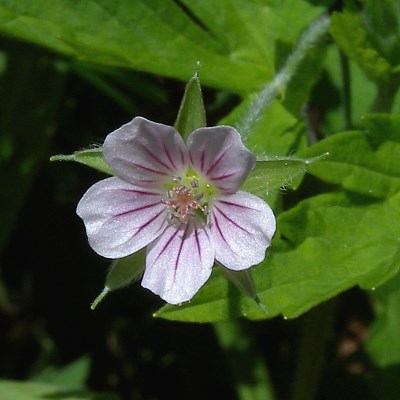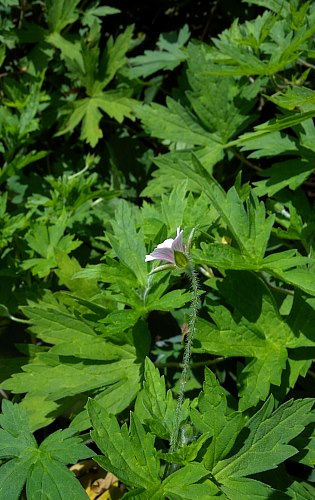Description: This wildflower is an annual or biennial consisting of much-branched sprawling stems with pairs of opposite leaves. The stems are 1-3' long, light green to dull red, hairy, and terete. Individual leaves are 1½–3" long and across; they are palmately cleft into 3-5 pointed lobes, while their margins are coarsely dentate and often subdivided into smaller pointed lobes. The upper leaf surface is medium green, while the lower surface is pale green; both sides are covered with fine appressed hairs. The lower surface also has longer hairs along the raised veins. The slender petioles are 1½–3" long, light green to reddish green, and terete. At the base of each petiole, there is a pair of linear-lanceolate stipules up to 1/3" (8 mm.) long. The slender pedicels of the flowers are 2½–4" long; there is only one pedicel with a single flower per pair of opposite leaves (rarely are there 2 flowers per flowering stalk). Each pedicel is light green to reddish green and hairy; there is a pair of tiny linear bracts toward the middle of its length.

Each pedicel
terminates in a single flower about ¼" across and a little longer in
length. Individual flowers consist of 5 rounded petals, 5 lanceolate
sepals with short awn-like tips, a pistil with 5 dull red stigmata, and
10 stamens with pale purple anthers. The petals are usually white with
fine rosy pink veins; other color variations may exist. The sepals are
light green, hairy along the exterior, and longitudinally veined. The
blooming period occurs during the summer and early fall and can last
2-3 months. Only a few flowers are in bloom at the same time. Each
flower is replaced by a finely hairy schizocarp (dry fruit) about ½"
long that consists of a beak above and an ovary with five rounded lobes
below. As it matures, the schizocarp changes from green to brown and
splits open into 5 narrow sections from the bottom to the top. Each of
these sections flings a single seed. This wildflower reproduces by
reseeding itself. At favorable sites, it forms colonies of plants.

Cultivation:
The preference appears to be partial sun, mesic conditions, and a
fertile loamy soil. It is possible, however, that other environmental
conditions are readily tolerated.
Range & Habitat:
Siberian Cranesbill is quite rare in Illinois; this plant has been
found in only a few counties in northern and central Illinois (see Distribution
Map), where it is not native. This wildflower is originally
from Eurasia. Habitats consist of disturbed open woodlands, areas along
the foundation of buildings, and waste areas. In Eurasia, Siberian
Cranesbill also occurs in boreal meadows, sometimes in great abundance.
At the present time, it is unclear how invasive this species will be in
Illinois.
Faunal Associations:
Very little is known about floral-faunal relationships for this
non-native species. The flowers are probably pollinated by small flies
(particularly Syrphid flies) and small bees (particularly Halictid
bees). Both nectar and pollen are available as floral rewards to such
visitors. One insect that sucks on the juices of Geranium spp.
is Macrosiphum geranii (Geranium Aphid). The seeds
of some Geranium spp. are eaten by such birds as
the Mourning Dove and Bobwhite Quail.
Photographic Location:
Along the building of the Channing-Murray Foundation on the campus of
the University of Illinois in Urbana, Illinois. At this location,
Siberian Cranesbill has been very abundant for several years.
Comments:
There are many species of Geranium in Illinois; most of these have been
introduced from Eurasia either deliberately or accidentally. These
species should not be confused with the common pot plants with showy
flowers that are called 'Geraniums.' The latter are cultivated Pelargonium
spp. from South Africa; they are also members of the Geranium
family. Siberian Cranesbill can be readily distinguished from other Geranium
spp. in Illinois by the following characteristic: Only a
single flower on a long pedicel is produced from a leaf axil. Similar
species produce flowers in clusters of 2 or more from their leaf axils.